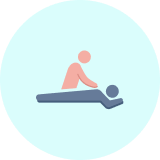Screens are everywhere these days— from educational apps to animated movies, devices like TVs smartphones and tablets play a significant role in how children learn and interact.
However, when screen time becomes excessive, it can negatively impact a child’s physical health, emotional wellbeing and social interactions.
The good news? You don’t have to eliminate screens to make a positive change. With a few thoughtful strategies, it’s entirely possible to help your child enjoy screen time in a way that supports their overall development.
Why balance matters
Not all screen time is harmful. In fact, video calls with family, educational games and quality content can be valuable tools that support learning and connection. But when screen use starts replacing physical activity, sleep or face-to-face interactions, it can affect a child’s development in several ways:
Reduced time for physical activity, which supports healthy posture, quality sleep and overall well-being.
Slower development of communication and social skills, especially in younger children who benefit most from in-person interactions.
Decreased ability to focus, as extended screen use can make it harder to concentrate on tasks over time.
Changes in mood and motivation, including increased irritability, lower energy levels and a higher risk of anxiety or low mood.
How much screen time is appropriate?
The Australian Physical Activity and Sedentary Behaviour Guidelines offer clear advice to help you find the right balance:
For Children Under 2:
Avoid screen time (excluding video chats).
At this age, interactive play and real-world engagement are far more beneficial.
For Ages 2–5:
Limit screen time to no more than one hour per day, and prioritise high-quality, age-appropriate content.
Activities such as talking, singing, reading and playing with others has greater benefits.
For Ages 5–17:
Recreational screen time (outside schoolwork) should be limited to two hours per day.
The less, the better—especially when the alternative is physical activity or in-person social time.
Remember, each family has its own dynamics. Use these recommendations as flexible guidelines and focus on creating a balance that works for your family.
Encouraging healthy screen habits
Changing screen habits doesn’t mean turning your life upside down. Small, consistent changes can make a big difference. Here are a few simple, effective strategies to support healthier screen use at home:
Set clear boundaries: Establish consistent screen time rules that are age-appropriate and easy to follow. When children know what to expect, it reduces resistance and builds routine.
Designate screen-free zones: Make areas like the dining table, bedrooms or car trips device-free. These spaces encourage more face-to-face connection.
Offer engaging alternatives: Screens are often a go-to when kids are bored. Keep a few fun, screen-free options on hand - crafts, puzzles, outdoor games or building toys can help keep their minds and bodies active without a device.
Lead by example: Kids learn by watching the adults around them. By managing your own screen use, especially during family time, you show that balance and being present really matter.
Make screen time more social: Whenever possible, turn screen time into a shared experience. Watch a family movie, play a group game or talk about what your child is watching, this encourages critical thinking and deeper connection.
A balanced approach pays off
When used mindfully and combined with physical activity, face-to-face communication and creative play, screen time can be both enjoyable and beneficial. The key is to start small. Focus on one or two areas, stay consistent and make adjustments as your family’s needs evolve.
Over time, these small shifts can lead to healthier habits and a more balanced daily routine. By setting up clear boundaries and offering meaningful screen-free alternatives, you’re not only supporting your child’s wellbeing—you’re helping them build life-long habits they can carry into adulthood.
This blog article was supported by AI generation and while intended to be helpful, should not be relied upon as individual health advice. Always consult a healthcare professional before making health decisions. The accuracy, completeness or recency of the information cannot be guaranteed and we cannot be held responsible for any loss incurred from acting on this information. Content developed in partnership with Health and Wellbeing Queensland.
Information source: hw.qld.gov.au/blog/how-much-screen-time-is-too-much




































